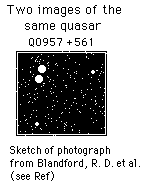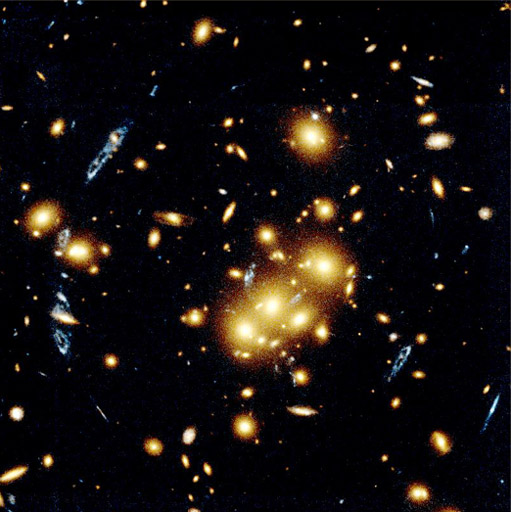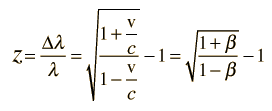Gravitational Lens
| Since light is bent by a gravity field according to general relativity, there is a possibility of focusing effects like that of a lens when there is a large collection of mass near the path of the light to us. The two brighter objects in the sketch to the right are interpreted as two images of the same quasar, Q0957 +561. The focusing matter is an intervening giant galaxy. |
 |

"In this photograph, light from the distant galaxy bends as it passes through the cluster, dividing the galaxy into five separate images. One image is near the center of the photograph; the others are at 6, 7, 8, and 2 o'clock. The light also has distorted the galaxy's image from a normal spiral shape into a more arc-shaped object. Astronomers are certain the blue-shaped objects are copies of the same galaxy because the shapes are similar. The cluster is 5 billion light-years away in the constellation Pisces, and the blue-shaped galaxy is about 2 times farther away." When the amount of bending is analyzed, the required bending mass is greater than can be accounted for from the visible mass of the cluster, so this is another piece of evidence for the existence of dark matter.
"Though the gravitational light-bending process is not new, Hubble's high resolution image reveals structures within the blue-shaped galaxy that astronomers have never seen before. Some of the structures are as small as 300 light-years across. The bits of white imbedded in the blue galaxy represent young stars; the dark core inside the ring is dust, the material used to make stars. This information, together with the blue color and unusual "lumpy" appearance, suggests a young, star-making galaxy."
"The picture was taken October 14, 1994 with the Wide Field Planetary Camera-2. Separate exposures in blue and red wavelengths were taken to construct this color picture.
Credit: W.N. Colley and E. Turner (Princeton University), J.A. Tyson (Bell Labs, Lucent Technologies) and NASA. "
Gravitational lensing has now been observed with a number of galaxies. In a study reported in the Astrophysical Journal in February 2006, Adam Bolton and colleagues at the Harvard-Smithsonian Center for Astrophysics described 19 galaxies that were distorting the images of more distant galaxies that were closely aligned with them. Eight of them were so closely aligned that they bent the light of the more distant galaxy into a ring of light called an Einstein ring. The observations were made by the Hubble Space Telescope, guided toward likely candidates for gravitational lensing by the Sloan Digital Sky Survey.
|
Index
Blanford |



